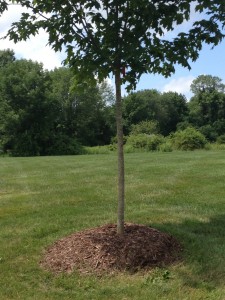Proper Tree Mulching
Mulching your landscape, for many, is an annual event to dress up your landscape for the new growing season. It is a spring cleaning of sorts. Whether you apply it yourself or hire a company, there is a right way and a wrong way to mulch your trees. Aside from the aesthetic reasons to mulch, there are important practical reasons too. Mulch:
-
holds the moisture above the root ball during the hot, dry months of summer.
-
protects the trunk of the tree from weedwacker and mower damage.
-
helps keep the base of the tree clean of last fall’s leaves reducing the amount of overwintering insects waiting for spring to feed.
Unfortunately, when done improperly, it can do more harm than good. The biggest mistake that applicators make is what the industry calls “volcano” mulching:
This is when the mulch is mounded up against the trunk. This is horrible for the health of your tree. It holds the moisture against the trunk causing tip die back, girdling roots, bark rot, and will weaken the tree making it susceptible to insect and disease problems.
Avoiding this is easy. It can be done is 6 easy steps:
-
Find a flat, sharp long handled garden spade. (file it very sharp, it saves your shoulders)
-
Mark your circle. I like to use tree marking paint because its available but a garden hose is great, or even your kids sidewalk chalk will do.
-
Cut the desired mulch circle using the sharpened spade around the base of the tree making sure to sever through all the roots of the sod. I like to use the drip line as a guide. Especially for new plantings. Older, well established trees need less.
-
Remove all the grass shaking off as much soil as possible. Banging the sod against the side of the shovel works really well.
-
Apply a few inches of mulch. Three inches is my rule of thumb. I find it keeps the moisture in and the weeds and grass out.
-
Most importantly, keep the root collar of the tree exposed. This is at the very base of the trunk where it starts to flare. When you finish, stand back and look. Follow the trunk down to the mulch. Does it thicken or flare at the base? If so, congratulations, you will have many years to enjoy your tree.
Happy spring and thanks for reading!






